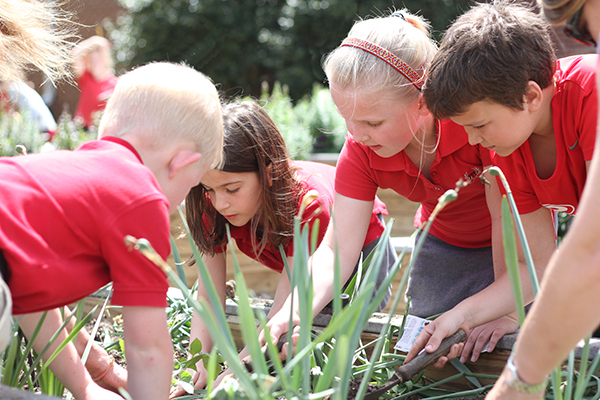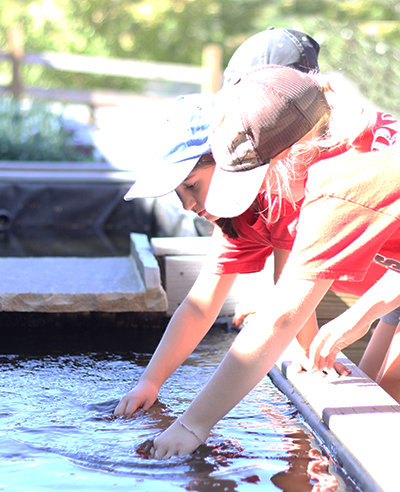Dr. Barry Shealy, FPD Assistant Headmaster
FPD Kindergarten Teacher Allison Lucas and I were recently discussing early childhood science when we noticed a pair of bluebirds outside her window. The brightly colored blue and red-brown male showed up first, followed by his elegant mate, grayer with blue accents, providing a perfect example of what early science experience is all about.
Difference between Seeing and Observing
An important science objective for young children is the difference between “seeing” and “observing.” I tell children that observing is thinking about what you see (just as listening is thinking about what you hear). With birdwatching, for example, I teach children to notice field marks – easily recognizable characteristics – like the flash of white when a mockingbird flies, red on a red-winged blackbird, or the blue and orange of the male bluebird. I also teach them to recognize birds by their behavior. There is no mistaking the killdeer nesting on FPD’s campus for another ground-loving bird like a robin or brown thrasher even if you cannot get a good view of its markings. It is exciting to see kids move from simply seeing birds to seeing mockingbirds, robins, wrens, and sparrows.
How this translates in a Christian worldview
In a Christian school, we have the opportunity to expand objectives to affect the way a child sees the world. The diversity of birds, for example, both their markings and behavior, has been an inspirational sign for me ever since I read every book about birds in my elementary school library. This diversity illustrates God’s creativity and goodness. Also, Jesus’ use of God’s care for birds as an illustration of His care for us has always been an intensely relevant encouragement to me (Matthew 6:24-34).
 Science has a key place in our early childhood curriculum and instruction because of our Christian philosophy of education. When we were created, God gave us the responsibility to care for and see to the appropriate use of creation (Genesis 1:26-28). We call this the Creation or Cultural Mandate (for information, see Ryken 22). This responsibility preceded the fall and is built into who we are as humans. God has given us a creation that is ordered and capable of being understood. He has made us in His image and given us the ability to study and make sense of our surroundings and, thus, fulfill our stewardship responsibility. These ideas provide the basis for science. Young children have a great capacity to observe, investigate, question, and formulate explanations. Providing them opportunities to develop and practice these skills is important to students’ overall development and, as discussed below, has significant impact on their later lives.
Science has a key place in our early childhood curriculum and instruction because of our Christian philosophy of education. When we were created, God gave us the responsibility to care for and see to the appropriate use of creation (Genesis 1:26-28). We call this the Creation or Cultural Mandate (for information, see Ryken 22). This responsibility preceded the fall and is built into who we are as humans. God has given us a creation that is ordered and capable of being understood. He has made us in His image and given us the ability to study and make sense of our surroundings and, thus, fulfill our stewardship responsibility. These ideas provide the basis for science. Young children have a great capacity to observe, investigate, question, and formulate explanations. Providing them opportunities to develop and practice these skills is important to students’ overall development and, as discussed below, has significant impact on their later lives.
Early childhood science is not simply a set of content objectives to memorize. It is a process; something students do. Early science includes –
- Observing and talking about what you see
- Asking questions about what you observe
- Noticing properties and describing them
- Noticing patterns, cause-effect, and change
- Crafting reasonable explanations using evidence
- Conducting simple investigations
And early science involves doing these things in the contexts of nature study/life science, physical science, and earth/space science (consider the Next Generation Science Standards).
Strong Predictors of Later Science Achievement
Researchers in a large longitudinal study found that participation in the types of experiences I have described above are strong predictors of later science achievement (Morgan et al 2016). More striking to me is that the gap in achievement between students who have and those who do not have these early experiences persists; no later experience seems to close this gap.
All of this background confirms our emphasis at FPD on active hands-on science with our youngest students and demonstrates the value of our campus resources and facilities. When Robyn Washburn’s kindergarten class recently spent time reading in the instru ctional gardens they were not only having a positive literacy experience, they were also observing and appreciating God’s creation. Last summer, even our Extended Day students were able to get into the act and consider change over time as they continued care of the sixth grade’s Cope’s Gray Tree Frogs as they changed from egg to tadpole to frogs (the eggs came from my back yard). A discussion of how and why the kindergarten bluebirds are different is a valuable conversation young children can have. I look forward to spending time with our kindergarten students on the nature trail soon. I am sure they will find something I have never seen or thought about before even though I have been going there since we built the trail 15 years ago.
ctional gardens they were not only having a positive literacy experience, they were also observing and appreciating God’s creation. Last summer, even our Extended Day students were able to get into the act and consider change over time as they continued care of the sixth grade’s Cope’s Gray Tree Frogs as they changed from egg to tadpole to frogs (the eggs came from my back yard). A discussion of how and why the kindergarten bluebirds are different is a valuable conversation young children can have. I look forward to spending time with our kindergarten students on the nature trail soon. I am sure they will find something I have never seen or thought about before even though I have been going there since we built the trail 15 years ago.
Of course, just as with literacy and mathematics, science development begins and is reinforced at home. Spending time outdoors, observing the weather, watching the stars and moon, talking about changes as plants and animals grow, predicting, and explaining can all be part of a child’s regular family experience.
If it is, then the experience will have a great impact on the child’s growth as he or she fulfills the calling and responsibilities God has given. Henry Cole’s book, I Took a Walk, is one of my favorite books to share with young children. It begins, “One spring morning I went for a walk and followed the path to the woods.” I won’t spoil the book for you, but recommend you check it out. Then, whether you read the book or not, make your own adventure with your child on a walk in the woods, through a garden, across a field, along a beach, or wherever you happen to be. You may be surprised what your child notices or even teaches you!
References –
Cole, Henry. I Took a Walk. New York: Greenwillow Books, 1998. Print.
Morgan, Paul L., George Farkas, Marianne M. Hillemeier, and Steve Maczuga. “Science Achievement Gaps Begin Very Early, Persist, and are Largely Explained by Modifiable Factors.” Educational Researcher 45.1 (January/February 2016): 7-17. Print.
NGSS. Next Generation Science Standards: For State, By States. Washington, DC: The National Academies Press, 2013. Print.
Ryken, Philip G. What is the Christian Worldview? Phillipsburg, NJ: P&R Publishing, 2006. Print.
Recommended Resources –
- All About Birds – http://www.allaboutbirds.org/guide
- Audubon Guide to North American Birds – https://www.audubon.org/bird-guide
